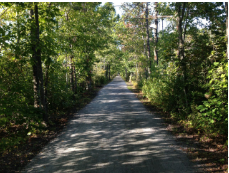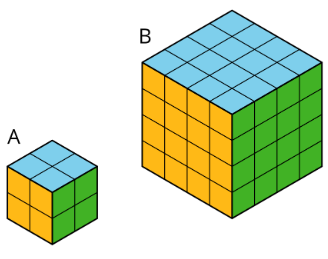17.4: More about Constant Speed
- Page ID
- 39942
Lesson
Let's investigate constant speed some more.
Exercise \(\PageIndex{1}\): Back on the Treadmill Again
While training for a race, Andre’s dad ran 12 miles in 75 minutes on a treadmill. If he runs at that rate:
- How long would it take him to run 8 miles?
- How far could he run in 30 minutes?
Exercise \(\PageIndex{2}\): Picnics on the Rail Trail

Kiran and Clare live 24 miles away from each other along a rail trail. One Saturday, the two friends started walking toward each other along the trail at 8:00 a.m. with a plan to have a picnic when they meet.
Kiran walks at a speed of 3 miles per hour while Clare walks 3.4 miles per hour.
- After one hour, how far apart will they be?
- Make a table showing how far apart the two friends are after 0 hours, 1 hour, 2 hours, and 3 hours.
- At what time will the two friends meet and have their picnic?
- Kiran says “If I walk 3 miles per hour toward you, and you walk 3.4 miles per hour toward me, it’s the same as if you stay put and I jog 6.4 miles per hour.” What do you think Kiran means by this? Is he correct?
- Several months later, they both set out at 8:00 a.m. again, this time with Kiran jogging and Clare still walking at 3.4 miles per hour. This time, they meet at 10:30 a.m. How fast was Kiran jogging?
Are you ready for more?
- On his trip to meet Clare, Kiran brought his dog with him. At the same time Kiran and Clare started walking, the dog started running 6 miles per hour. When it got to Clare it turned around and ran back to Kiran. When it got to Kiran, it turned around and ran back to Clare, and continued running in this fashion until Kiran and Clare met. How far did the dog run?
- The next Saturday, the two friends leave at the same time again, and Kiran jogs twice as fast as Clare walks. Where on the rail trail do Kiran and Clare meet?
Exercise \(\PageIndex{3}\): Swimming and Biking
Jada bikes 2 miles in 12 minutes. Jada’s cousin swims 1 mile in 24 minutes.
- Who is moving faster? How much faster?
- One day Jada and her cousin line up on the end of a swimming pier on the edge of a lake. At the same time, they start swimming and biking in opposite directions.
- How far apart will they be after 15 minutes?
- How long will it take them to be 5 miles apart?
Summary
When two objects are each moving at a constant speed and their distance-to-time ratios are equivalent, we say that they are moving at the same speed. If their time-distance ratios are not equivalent, they are not moving at the same speed.
We describe speed in units of distance per unit of time, like miles per hour or meters per second.
- A snail that crawls 5 centimeters in 2 minutes is traveling at a rate of 2.5 centimeters per minute.
- A toddler that walks 9 feet in 6 seconds is traveling at a rate of 1.5 feet per second.
- A cyclist who bikes 20 kilometers in 2 hours is traveling at a rate of 10 kilometers per hour.
We can also use pace to describe distance and time. We measure pace in units such as hours per mile or seconds per meter.
- A snail that crawls 5 centimeters in 2 minutes has a pace of 0.4 minutes per centimeter.
- A toddler walking 9 feet in 6 seconds has a pace of \(\frac{2}{3}\) seconds per foot.
- A cyclist who bikes 20 kilometers in 2 hours has a pace of 0.1 hours per kilometer.
Speed and pace are reciprocals. Both can be used to compare whether one object is moving faster or slower than another object.
- An object with the higher speed is faster than one with a lower speed because the former travels a greater distance in the same amount of time.
- An object with the greater pace is slower than one with a smaller pace because the former takes more time to travel the same distance.
Because speed is a rate per 1 unit of time for ratios that relate distance and time, we can multiply the amount of time traveled by the speed to find the distance traveled.
| time (minutes) | distance (centimeters) |
|---|---|
| \(2\) | \(5\) |
| \(1\) | \(2.5\) |
| \(4\) | \(4\cdot (2.5)\) |
Glossary Entries
Definition: Pace
Pace is one way to describe how fast something is moving. Pace tells how much time it takes the object to travel a certain distance.
For example, Diego walks at a pace of 10 minutes per mile. Elena walks at a pace of 11 minutes per mile. Elena walks slower than Diego, because it takes her more time to travel the same distance.
Definition: Speed
Speed is one way to describe how fast something is moving. Speed tells how much distance the object travels in a certain amount of time.
For example, Tyler walks at a speed of 4 miles per hour. Priya walks at a speed of 5 miles per hour. Priya walks faster than Tyler, because she travels more distance in the same amount of time.
Definition: Unit Price
The unit price is the cost for one item or for one unit of measure. For example, if 10 feet of chain link fencing cost $150, then the unit price is \(150\div 10\), or $15 per foot.
Definition: Unit Rate
A unit rate is a rate per 1.
For example, 12 people share 2 pies equally. One unit rate is 6 people per pie, because \(12\div 2=6\). The other unit rate is \(\frac{1}{6}\) of a pie per person, because \(2\div 12=\frac{1}{6}\).
Practice
Exercise \(\PageIndex{4}\)
A kangaroo hops 2 kilometers in 3 minutes. At this rate:
- How long does it take the kangaroo to travel 5 kilometers?
- How far does the kangaroo travel in 2 minutes?
Exercise \(\PageIndex{5}\)
Mai runs around a 400-meter track at a constant speed of 250 meters per minute. How many minutes does it take Mai to complete 4 laps of the track? Explain or show your reasoning.
Exercise \(\PageIndex{6}\)
At 10:00 a.m., Han and Tyler both started running toward each other from opposite ends of a 10-mile path along a river. Han runs at a pace of 12 minutes per mile. Tyler runs at a pace of 15 minutes per mile.
- How far does Han run after a half hour? After an hour?
- Do Han and Tyler meet on the path within 1 hour? Explain or show your reasoning.
Exercise \(\PageIndex{7}\)
Two skateboarders start a race at the same time. Skateboarder A travels at a steady rate of 15 feet per second. Skateboarder B travels at a steady rate of 22 feet per second. After 4 minutes, how much farther will Skateboarder B have traveled? Explain your reasoning.
(From Unit 2.5.2)
Exercise \(\PageIndex{8}\)
There are 4 tablespoons in \(\frac{1}{4}\) cup. There are 2 cups in 1 pint. How many tablespoons are there in 1 pint? If you get stuck, consider drawing a double number line or making a table.
(From Unit 3.2.3)
Exercise \(\PageIndex{9}\)
Two larger cubes are made out of unit cubes. Cube A is 2 by 2 by 2. Cube B is 4 by 4 by 4. The side length of Cube B is twice that of Cube A.
- Is the surface area of Cube B also twice that of Cube A? Explain or show your reasoning.
- Is the volume of Cube B also twice that of Cube A? Explain or show your reasoning.

(From Unit 1.5.1)

